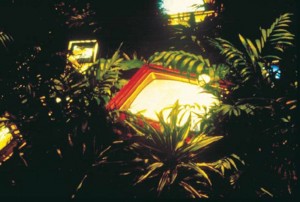Monkeying Around
I had always thought of artists as people who possessed a certain magic about them. We’ve all heard of the phrase “Great Masters” to describe da Vinci, Michelangelo, Van Gogh or Cezanne. However, after spending some time at art school, I have downgraded my impression of artists. I now see that artists might find themselves about one step above monkeys.
No one illustrates this more clearly than the artist Nam June Paik who did installations with TV sets in the 1970s. My favorite, “TV Garden” is a jungle-like garden where instead of flowers, there are television sets that appear to be growing from the ground. As a work, TV Garden makes sense; Paik was responding to a big cultural change in the 1970s when televisions and advertising suddenly became a huge part of American life. But what I love about it is that it appears as though he had seen a television set with a certain innocence, perhaps scratching the top of his head with one hand and scratching the resulting open armpit with the other, thinking, wow this is pretty. I’ll compare it to other things that are pretty. He had ignored the seriousness of a television set, which delivers news, perpetuates consumer culture, and symbolizes a sedentary lifestyle, and focused instead on its sparkly lights and aesthetics.
If TV Garden is the end result, the golden morsel that we celebrate, then what journey did Paik take to get there? At my art school, the training I’m getting is to learn how to show people my unique world vision. To do this, I am to live by my own rules. Yes, there are technical things to learn, such as how to draw in a way that makes something look like it has a volume, or how to use color to describe actual shading. But it seems like the real training involves tapping into our inner child.
I spend six hours every Thursday (well, only five and half since he pushed class start time back half an hour to afford him extra sleep in the morning) with a teacher named Howard Eige. There are no assignments in this class. Instead, we just show up with paints, brushes, something to paint on, and our own ideas for what to paint about. He strolls around the classroom offering advice to students. “Forget the logic; create your own rules,” I’ll often hear him say loudly in a New York accent. He wants us as students to identify something interesting and make decisions about how to show that as a painting on a canvas.
This process of taking in information extends beyond the realm of art-making. When my friend accidentally sliced her finger open with an easel in class and was deciding whether or not to go to the hospital for stitches, she asked me to tap the tip of her finger with the handle of a paintbrush to see if she still had feeling. Sure, why not. I found myself acting as a doctor, performing a test. “Now?” I’d ask. “Yes,” she responded. “Can you feel it now?”
This scene must have been an odd sight, and Howard was on top of it. Seconds later he appeared, and said, “my turn.” I then found myself tapping the end of his finger with a paintbrush. Of course, since his finger wasn’t sliced open, he could feel every tap from the brush, but I appreciate his questioning of assumptions. He was merely gathering information in his unique way.

